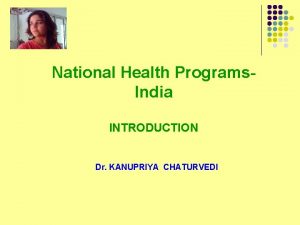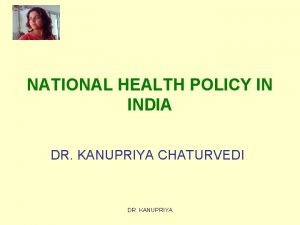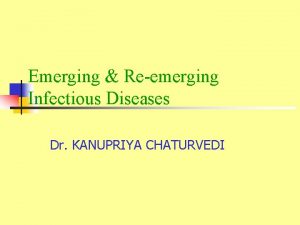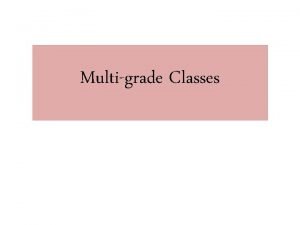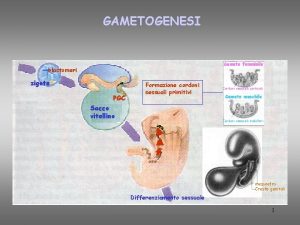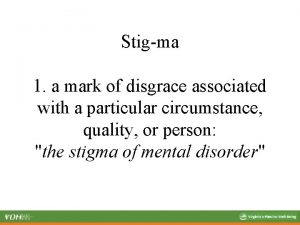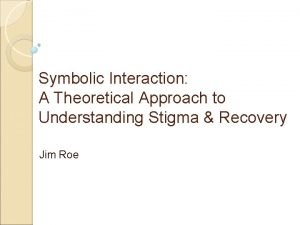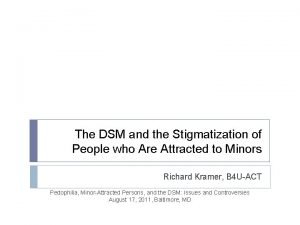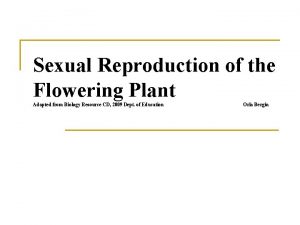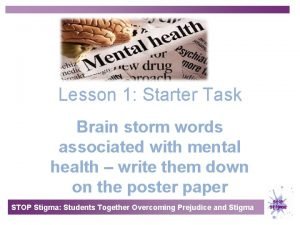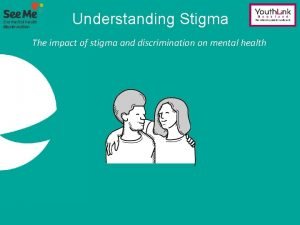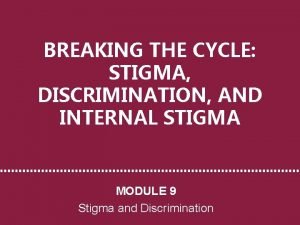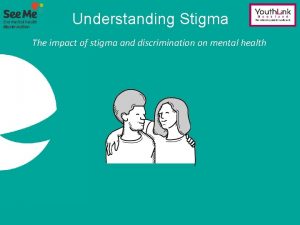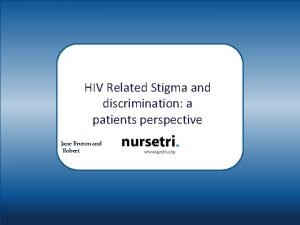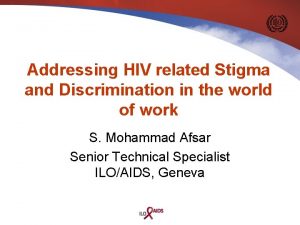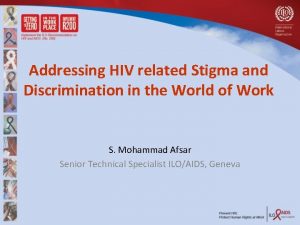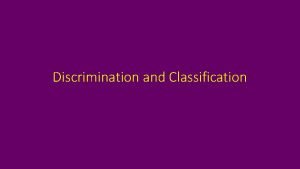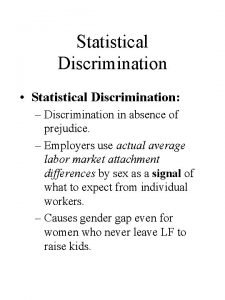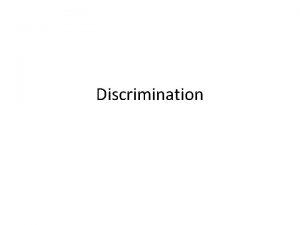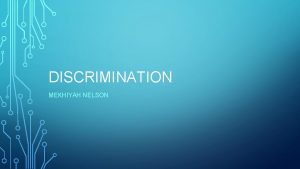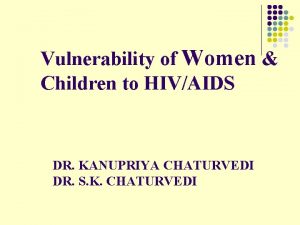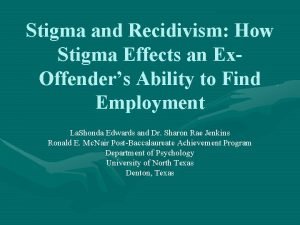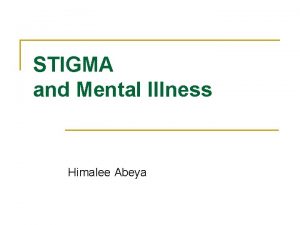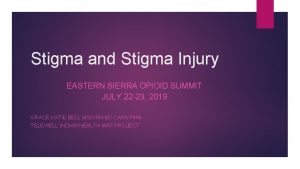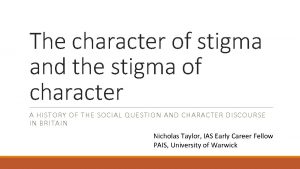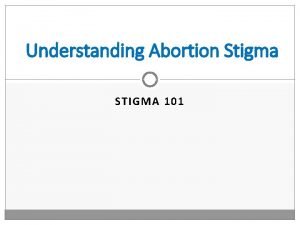Stigma and Discrimination Related to HIVAIDS Dr KANUPRIYA




















- Slides: 20

Stigma and Discrimination Related to HIV/AIDS Dr KANUPRIYA CHATURVEDI Dr S. K. CHATURVEDI

Lesson Objectives • Define and identify HIV/AIDS-related stigma and discrimination • Better understand international and national human right issues • Clarify personal values and attitudes with regard to HIV/AIDS prevention and care • Know how to address stigma and discrimination in the context of providing HIV services

Definition • The Microsoft Word Dictionary defines stigma as the shame or disgrace attached to something regarded as socially unacceptable. Sociologists have taken this a bit further. In a seminal study on stigma in 1963, stigma was defined as an attribute that is seen as deeply discrediting to a person or group (Goffmann). Those attributes could be an illness, physical deformity, aberrant behaviour or social group (based upon religion or ethnicity, etc. ). Stigma lets people or groups see differences or "others" in a negative light while confirming their own sense of normalcy and decency. • Subsequent researchers have viewed this more as a social process that creates or perpetuates social inequities and which is used to legitimise discrimination. While this is generally true, stigma can also be a primal human response- particularly in the case of fearing a disease that is transmissible and potentially incurable.

Stigma and discrimination • Stigma refers to unfavourable attitudes and beliefs directed toward someone or something • Discrimination is the treatment of an individual or group with partiality or prejudice • Stigmatization reflects an attitude • Discrimination is an act or behavior

Root Causes 1. The role of knowledge about HIV and AIDS and fear surrounding it – Ogden and Nyblade believe that the fear of transmission from casual transmission, and the various "what if scenarios" are the result of 1) the lack of specific, in-depth information about HIV transmission, 2) fear-based public messaging, and 3) the evolving nature of knowledge about HIV and AIDS. 2. The role of values, norms, and moral judgment – This stigma is exacerbated by the seriousness of the illness, its mysterious nature, and its association with behaviours that are either illegal or socially sensitive (e. g. , sex, prostitution, and drug use). Also relevant is the perception that HIV infection is the product of personal choice: that one chooses to engage in "bad" behaviours that put one at risk and so it is "one's own fault" if HIV infection ensues. "

Expressions and forms of stigma • Ogden and Nyblade divide stigma into four loosely defined groups: physical, social, verbal and institutional. – Social stigma – Isolated from community – Voyeurism: any interest may be morbid curiosity or mockery rather than genuine concern – Loss of social role/identity: social `death`, loss of standing and respect – Physical stigma – Isolated, shunned, abandoned – Separate living space, eating utensils – Violence

Forms of stigma (contd. ) – Verbal stigma – Gossip, taunting, scolding – Labelling: in Africa: "moving skeleton, " "walking corpse, " and "keys to the mortuary. " In Vietnam: "social evils, " and "scum of society. " – Institutionalised stigma – Barred from jobs, scholarships, visas – Denial of health services – Police harrassment (eg of sex workers, HIV -positive actvists in China, outreach workers in India)

Challenge HIV-related stigma is increasingly recognized as the single greatest challenge to slowing the spread of HIV/AIDS – a threefold epidemic • HIV • AIDS • Stigma, discrimination, and denial

Human rights • Freedom from discrimination is a fundamental human right • Discrimination on the basis of HIV/AIDS status, actual or presumed, is prohibited by existing human rights standards • Discrimination against persons living with HIV/AIDS (PLWHA), or those thought to be infected, is a clear human rights violation

Effects of stigma • Social isolation • Limited rights and reduced access to services • HIV/AIDS related stigma fuels new HIV infections • Secondary stigma (stigma by association)

Stigma in service delivery • Discourages access to ANC services • Prevents access to counselling , HIV testing and MTCT services • Discourages disclosure of HIV test results to partner(s) • Discourages acceptance of MTCT interventions • Inhibits use of safer infant-feeding practices • Confers secondary stigmatisation on the child

Addressing stigma • Interventions addressing HIV-related stigma can take place at all levels: • National • Community and social/cultural • MTCT site/facility • Individual

National Level Interventions to Address Stigma – Support • Human rights legislation • National efforts to scale up ARV treatment • Funding for PPTCT services, and training – Share • MTCT success stories

Community Level Interventions • In the community, promote • HIV awareness and knowledge • MTCT activities as integral to health care and HIV/AIDS prevention and treatment • Referrals to and from MTCT services • Awareness of MTCT interventions

Community level interventions (contd. ) Support • Partnership with schools, social and community organizations • PLWHA ( people living with HIV/AIDS) in implementing initiatives • Networking with needed linkages • Ongoing training

Programme level interventions • Integrate MTCT into antenatal services • Encourage partner involvement • Enlist partner and family support to decrease HIV transmission

Addressing stigma • Educate and train healthcare providers in • HIV transmission • Activities to address stigma • Awareness of language that describes PLWHA • MTCT-related policies • Counselling and safer infant feeding practices

Addressing stigma Enlist manager’s help to ensure policies and procedures are in place and implemented for: • Non-discrimination policies • Confidentiality • Universal precautions • Post-exposure prophylaxis (PEP)

Summary • Stigmatisation reflects an attitude • Discrimination is an act or behaviour • Stigma and discrimination are often linked to violations of human rights • Human rights declarations affirm all peoples’ rights to be free from discrimination, including discrimination based on HIV/AIDS status. • HIV/AIDS-related stigmatisation and discrimination can discourage access to key HIV services, including: • Testing • MTCT services • Antenatal care • ARV prophylaxis

Summary contd • Stigma discourages -Disclosure of HIV status -Acceptance of safer infant-feeding practices -Access to education, counselling, and treatment even when such services are available and affordable • The MTCT programs and staff can help reduce stigma and discrimination in the healthcare setting, in the community, and at the national level • Encourage MTCT staff to serve as role models • Involve PLWHA • Promote partner participation and community support
 Dr. kanupriya chaturvedi
Dr. kanupriya chaturvedi Dr. kanupriya chaturvedi
Dr. kanupriya chaturvedi Kanupriya host death
Kanupriya host death Principles of primary health care
Principles of primary health care Two types of physical fitness
Two types of physical fitness What is skill-related fitness? *
What is skill-related fitness? * What is multigrade
What is multigrade Anther and stigma
Anther and stigma Part of a flower comprising stigma style and ovary
Part of a flower comprising stigma style and ovary Six part of plant
Six part of plant Stigma ovaio
Stigma ovaio Epicotyl and hypocotyl
Epicotyl and hypocotyl The mark
The mark Stigma image
Stigma image Associatief stigma
Associatief stigma Symbolic stigma
Symbolic stigma Stigma image
Stigma image Fruits and seeds formation
Fruits and seeds formation Stigma image
Stigma image Keratan membujur sekuntum bunga
Keratan membujur sekuntum bunga What is stigma
What is stigma
